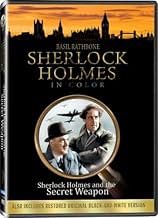VALUTAZIONE IMDb
6,5/10
6847
LA TUA VALUTAZIONE
Aggiungi una trama nella tua linguaSherlock Holmes and Doctor Watson must protect a Swiss inventor of an advanced bomb sight from falling into German hands.Sherlock Holmes and Doctor Watson must protect a Swiss inventor of an advanced bomb sight from falling into German hands.Sherlock Holmes and Doctor Watson must protect a Swiss inventor of an advanced bomb sight from falling into German hands.
Karen Verne
- Charlotte Eberli
- (as Kaaren Verne)
Rudolph Anders
- Braun
- (non citato nei titoli originali)
Ted Billings
- Barfly
- (non citato nei titoli originali)
Whit Bissell
- London Bobbie
- (non citato nei titoli originali)
Veda Ann Borg
- Bar Singer
- (voce)
- (non citato nei titoli originali)
Paul Bryar
- Swiss Waiter
- (non citato nei titoli originali)
John Burton
- RAF Officer
- (non citato nei titoli originali)
Vicki Campbell
- Woman RAF Pilot
- (non citato nei titoli originali)
Gerard Cavin
- Scotland Yard Man
- (non citato nei titoli originali)
Harry Cording
- Jack Brady
- (non citato nei titoli originali)
James Craven
- RAF Officer Watching Bombsight Test
- (non citato nei titoli originali)
Trama
Lo sapevi?
- QuizThe set used for Prof. Moriarty's hideout was used as a pub/bar in La voce del terrore (1942).
- BlooperWhen they first test the bomb sight, on the first pass, both the terrain in view and the terrain where the bombs hit is clearly stock footage of bomb tests in the southern California desert.
- Citazioni
Professor Moriarty: Brilliant man, Sherlock Holmes. Too bad he was honest.
- Curiosità sui creditiOpening credits prologue: SWITZERLAND
- Versioni alternativeAlso available in a computer-colorized version.
- ConnessioniEdited into Who Dunit Theater: Sherlock Holmes and the Secret Weapon (2016)
- Colonne sonoreRule Britannia
(1740) (uncredited)
Music by Thomas Augustine Arne
Played in the score when London is shown
Recensione in evidenza
In the midst of WWII, Holmes is involved in the protection of a scientist working on a secret weapon that may prove to be a turning point against the Nazi's. When the scientist and his formulae goes missing, Holmes becomes involved in a rush to rescue the man and prevent nemesis Professor Moriarty getting hold of the rest of the formulae.
Although I'm not a major fan of the Holmes films where he finds himself in the modern day world, this is one of the better ones I have seen thus far. The plot is a little thick at the start but really gets going when the scientist goes missing. The investigation by Holmes is very engaging and the climax has a nice couple of scenes where Holmes and Moriarty match wits.
Rathbone makes a good Holmes as always and here he happily hasn't as bad a haircut as he did in some of the modern films. Bruce is much better than usual - he is less of a mug and is made less fun of by Holmes, he actually shows a bit of sense about him. Indeed so does Lestrade (Hoey), so often a comedy figure, it's nice to see him involved a bit more than usual! Atwill's Moriarty is good but I always saw him as a leaner, meaner man - Atwill looks more like Watson than Sherlock, even though their battle of wits is good I never felt that he was any match for Holmes, never mind being a nemesis.
Overall I enjoyed this film. It does have a small bit of propaganda at the very end but, unlike some of the other films, doesn't ram it down your throat - by making it about Moriarty rather than Nazi goons, the film works better. It has a slow start but it opens up to be very enjoyable.
Although I'm not a major fan of the Holmes films where he finds himself in the modern day world, this is one of the better ones I have seen thus far. The plot is a little thick at the start but really gets going when the scientist goes missing. The investigation by Holmes is very engaging and the climax has a nice couple of scenes where Holmes and Moriarty match wits.
Rathbone makes a good Holmes as always and here he happily hasn't as bad a haircut as he did in some of the modern films. Bruce is much better than usual - he is less of a mug and is made less fun of by Holmes, he actually shows a bit of sense about him. Indeed so does Lestrade (Hoey), so often a comedy figure, it's nice to see him involved a bit more than usual! Atwill's Moriarty is good but I always saw him as a leaner, meaner man - Atwill looks more like Watson than Sherlock, even though their battle of wits is good I never felt that he was any match for Holmes, never mind being a nemesis.
Overall I enjoyed this film. It does have a small bit of propaganda at the very end but, unlike some of the other films, doesn't ram it down your throat - by making it about Moriarty rather than Nazi goons, the film works better. It has a slow start but it opens up to be very enjoyable.
- bob the moo
- 24 dic 2003
- Permalink
I più visti
Accedi per valutare e creare un elenco di titoli salvati per ottenere consigli personalizzati
- How long is Sherlock Holmes and the Secret Weapon?Powered by Alexa
Dettagli
- Data di uscita
- Paese di origine
- Lingue
- Celebre anche come
- Sherlock Holmes and the Secret Weapon
- Luoghi delle riprese
- Azienda produttrice
- Vedi altri crediti dell’azienda su IMDbPro
- Tempo di esecuzione1 ora 8 minuti
- Colore
- Proporzioni
- 1.37 : 1
Contribuisci a questa pagina
Suggerisci una modifica o aggiungi i contenuti mancanti





































